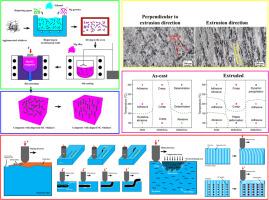Comparative study of wear behavior of magnesium matrix composite reinforced with silicon carbide particles and whiskers before and after extrusion
IF 13.8
1区 材料科学
Q1 METALLURGY & METALLURGICAL ENGINEERING
引用次数: 0
Abstract
In the current study the wear behavior of the ZK60/SiC composites reinforced by particles and whiskers in both as-cast and extruded conditions was examined. Furthermore, the wear behavior of the extruded samples along the extrusion direction and perpendicular to the extrusion direction was studied. The wear tests were performed at temperatures of 100, 200, and 300 °C under loads of 10, 20, and 30 N. The results showed that the whisker-reinforced sample (5.8 × 10–4 g/[N.m]) had higher wear resistance than the particle-reinforced sample (1.3 × 10–3 g/[N.m]). The lowest wear rate was observed for the extruded sample in the extrusion direction (3.53 × 10−4 g/[N.m]). It was also found that the wear rate increased by ∼20 % with increasing temperature, but in the ZK60/SiCw sample, dynamic precipitation increased the wear resistance. The coefficient of friction was also found to increase with rising temperature, showing an increase of approximately 12.5 % at a 10 N load and 20 % at a 30 N load. Examination of the worn surfaces by scanning electron microscopy showed that the as-cast ZK60 alloy at 100 °C had the oxidative-abrasive as the dominant mechanism. It was found that by extruding the sample, the strength of the sample increased and the mechanism changed to adhesive wear. In the ZK60/SiCp composite, the viscoplastic wear mechanism was dominant. Although in the extruded sample the dominant mechanism changed to plastic deformation. As temperature increases, the viscoplastic wear mechanism became dominant again. In the as-cast ZK60/SiCw composite, the abrasive wear mechanism changed to delamination with increasing temperature. By extruding the sample, the dominant mechanism changed to adhesive wear. Finally, dynamic precipitation induced by temperature caused an increase in the wear resistance.

碳化硅颗粒和晶须增强镁基复合材料挤压前后磨损性能的对比研究
本文研究了颗粒增强和晶须增强ZK60/SiC复合材料在铸态和挤压态下的磨损行为。进一步研究了挤压试样沿挤压方向和垂直于挤压方向的磨损行为。在100、200和300℃的温度下,在10、20和30 N的载荷下进行了磨损试验,结果表明,晶须增强试样的强度为5.8 × 10 - 4 g/[N;m])的耐磨性高于颗粒增强试样(1.3 × 10 - 3g /[N.m])。挤压试样在挤压方向的磨损率最低(3.53 × 10−4 g/[N.m])。随着温度的升高,磨损率提高了~ 20%,但在ZK60/SiCw样品中,动态析出提高了耐磨性。摩擦系数也随着温度的升高而增加,在10 N载荷下增加约12.5%,在30 N载荷下增加约20%。对铸态ZK60合金在100℃下的磨损表面进行扫描电镜观察,发现铸态ZK60合金的主要磨损机理是氧化磨粒。结果表明,挤压试样使试样的强度提高,其磨损机理转变为黏着磨损。在ZK60/SiCp复合材料中,粘塑性磨损机制占主导地位。但在挤压试样中,主要机制转变为塑性变形。随着温度的升高,粘塑性磨损机制再次占主导地位。在铸态ZK60/SiCw复合材料中,随着温度的升高,磨粒磨损机制转变为分层。挤压后试样的主要磨损机制转变为粘着磨损。最后,温度引起的动态析出使耐磨性提高。
本文章由计算机程序翻译,如有差异,请以英文原文为准。
求助全文
约1分钟内获得全文
求助全文
来源期刊

Journal of Magnesium and Alloys
Engineering-Mechanics of Materials
CiteScore
20.20
自引率
14.80%
发文量
52
审稿时长
59 days
期刊介绍:
The Journal of Magnesium and Alloys serves as a global platform for both theoretical and experimental studies in magnesium science and engineering. It welcomes submissions investigating various scientific and engineering factors impacting the metallurgy, processing, microstructure, properties, and applications of magnesium and alloys. The journal covers all aspects of magnesium and alloy research, including raw materials, alloy casting, extrusion and deformation, corrosion and surface treatment, joining and machining, simulation and modeling, microstructure evolution and mechanical properties, new alloy development, magnesium-based composites, bio-materials and energy materials, applications, and recycling.
 求助内容:
求助内容: 应助结果提醒方式:
应助结果提醒方式:


